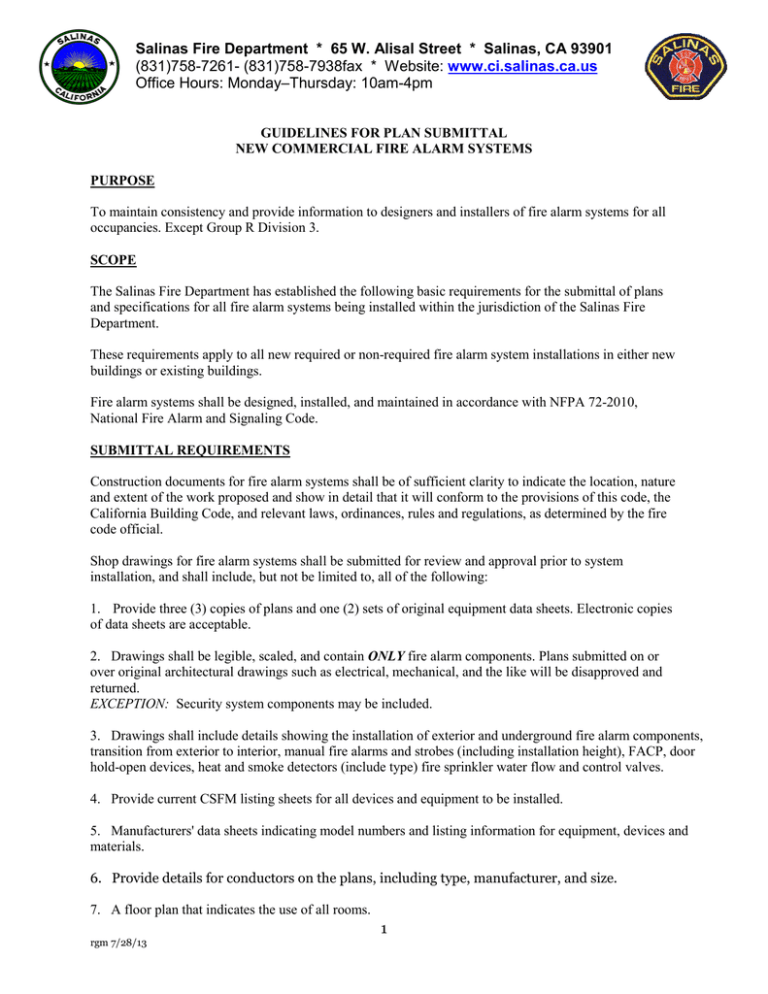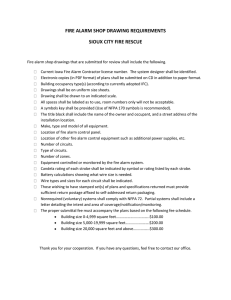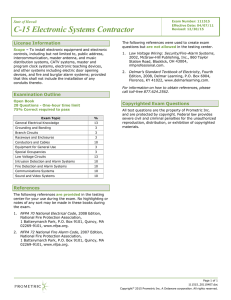Booth Construction/Location
advertisement

Salinas Fire Department * 65 W. Alisal Street * Salinas, CA 93901 (831)758-7261- (831)758-7938fax * Website: www.ci.salinas.ca.us Office Hours: Monday–Thursday: 10am-4pm GUIDELINES FOR PLAN SUBMITTAL NEW COMMERCIAL FIRE ALARM SYSTEMS PURPOSE To maintain consistency and provide information to designers and installers of fire alarm systems for all occupancies. Except Group R Division 3. SCOPE The Salinas Fire Department has established the following basic requirements for the submittal of plans and specifications for all fire alarm systems being installed within the jurisdiction of the Salinas Fire Department. These requirements apply to all new required or non-required fire alarm system installations in either new buildings or existing buildings. Fire alarm systems shall be designed, installed, and maintained in accordance with NFPA 72-2010, National Fire Alarm and Signaling Code. SUBMITTAL REQUIREMENTS Construction documents for fire alarm systems shall be of sufficient clarity to indicate the location, nature and extent of the work proposed and show in detail that it will conform to the provisions of this code, the California Building Code, and relevant laws, ordinances, rules and regulations, as determined by the fire code official. Shop drawings for fire alarm systems shall be submitted for review and approval prior to system installation, and shall include, but not be limited to, all of the following: 1. Provide three (3) copies of plans and one (2) sets of original equipment data sheets. Electronic copies of data sheets are acceptable. 2. Drawings shall be legible, scaled, and contain ONLY fire alarm components. Plans submitted on or over original architectural drawings such as electrical, mechanical, and the like will be disapproved and returned. EXCEPTION: Security system components may be included. 3. Drawings shall include details showing the installation of exterior and underground fire alarm components, transition from exterior to interior, manual fire alarms and strobes (including installation height), FACP, door hold-open devices, heat and smoke detectors (include type) fire sprinkler water flow and control valves. 4. Provide current CSFM listing sheets for all devices and equipment to be installed. 5. Manufacturers' data sheets indicating model numbers and listing information for equipment, devices and materials. 6. Provide details for conductors on the plans, including type, manufacturer, and size. 7. A floor plan that indicates the use of all rooms. rgm 7/28/13 1 8. Locations of alarm-initiating devices. 9. Locations of alarm notification appliances, including candela ratings for visible alarm notification appliances. 10. Location of fire alarm control unit, transponders and notification power supplies. 11. Annunciators. 12. Power connection.. 13. Battery calculations. 14. Conductor type and sizes. 15. Voltage drop calculations. 16. Details of ceiling height and construction. 17. The interface of fire safety control functions. 18. Classification of the supervising station. 19. All plans and shop drawings shall use the symbols identified in NFPA 170, Standard for Fire Safety and Emergency Symbols WIRING Wiring shall comply with the requirements of California Electrical Code and NFPA 72. Wireless protection systems utilizing radio-frequency transmitting devices shall comply with the special requirements for supervision of low-power wireless systems in NFPA 72. POWER SUPPLIES The primary and secondary power supply for the fire alarm system shall be provided in accordance with NFPA 72. ZONES Annunciation and notification, zoning shall be in accordance with the following: 1. Where the fire-protective signaling system serves more than one building, each building shall be considered as a separate zone. 2. Each floor of a building shall be considered as a separate zone. 3. Each section of floor of a building that is separated by fire walls or by horizontal exits shall be considered as a separate zone. 4. Each zone shall not exceed 22,500 square feet. The length of any zone shall not exceed 300 feet in any direction. Exception: Automatic sprinkler system zones shall not exceed the area permitted by NFPA 13. 5. Annunciation shall be further divided into zones where deemed necessary by the enforcing agency. ANNUNCIATION Alarm, supervisory and trouble signals shall be annunciated in the main control unit by means of an audible signal and a visual display in accordance with NFPA 72. Identification of the type of alarm and supervisory initiating devices, such as manual, automatic, sprinkler waterflow, sprinkler valve supervisory, fire-pump supervisory, etc., shall be separately indicated. 2 An annunciator panel and associated controls shall be provided in an approved remote location where deemed necessary by the fire departemnt. The visual zone indication shall lock in until the system is reset and shall not be canceled by the operation of an audible alarm-silencing switch. FIRE PROTECTION EQUIPMENT IDENTIFICATION AND ACCESS Fire protection equipment shall be identified in an approved manner. Rooms containing controls for airconditioning systems, sprinkler risers and valves, or other fire detection, suppression or control elements shall be identified for the use of the fire department. Approved signs required to identify fire protection equipment and equipment location shall be constructed of durable materials, permanently installed and readily visible. CFC 509.1 Identification. Approved access shall be provided and maintained for all fire protection equipment to permit immediate safe operation and maintenance of such equipment. Storage, trash and other materials or objects shall not be placed or kept in such a manner that would prevent such equipment from being readily accessible. CFC 509.2 Equipment access. INSTALLATION, ACCEPTANCE TESTING Upon completion of the installation, the fire alarm system and all fire alarm components shall be tested in accordance with NFPA 72. 907.8 Acceptance tests and completion. After acceptance testing has been completed and witnessed by a representative of the Salinas Fire Department, the installing company to the fire department and the owner/occupant shall provide a completed NFPA 72 Record of Completion. At the completion of the project, operating, testing, and maintenance instructions and record drawings ("as builts") and equipment specifications shall be provided at an approved location. Such documentation shall be maintained on site and accessible to the Salinas Fire Department and the fire alarm system service provider at all times. CFC 907.8.3 Instructions. If the installing contractor will not be providing the maintenance, testing, and servicing of all equipment in accordance to NFPA 72 requirements, it shall be the responsibility of the building owner to provide a copy of the maintenance contract to the Fire Inspector upon completion of all final field inspections and tests. The building owner shall be responsible to maintain the fire and life safety systems in an operable condition at all times. Service personnel shall meet the qualification requirements of NFPA 72 for maintaining, inspecting and testing such systems. A written record shall be maintained and shall be made available to the fire department. CFC 907.9.5 Maintenance, inspection and testing. 3



